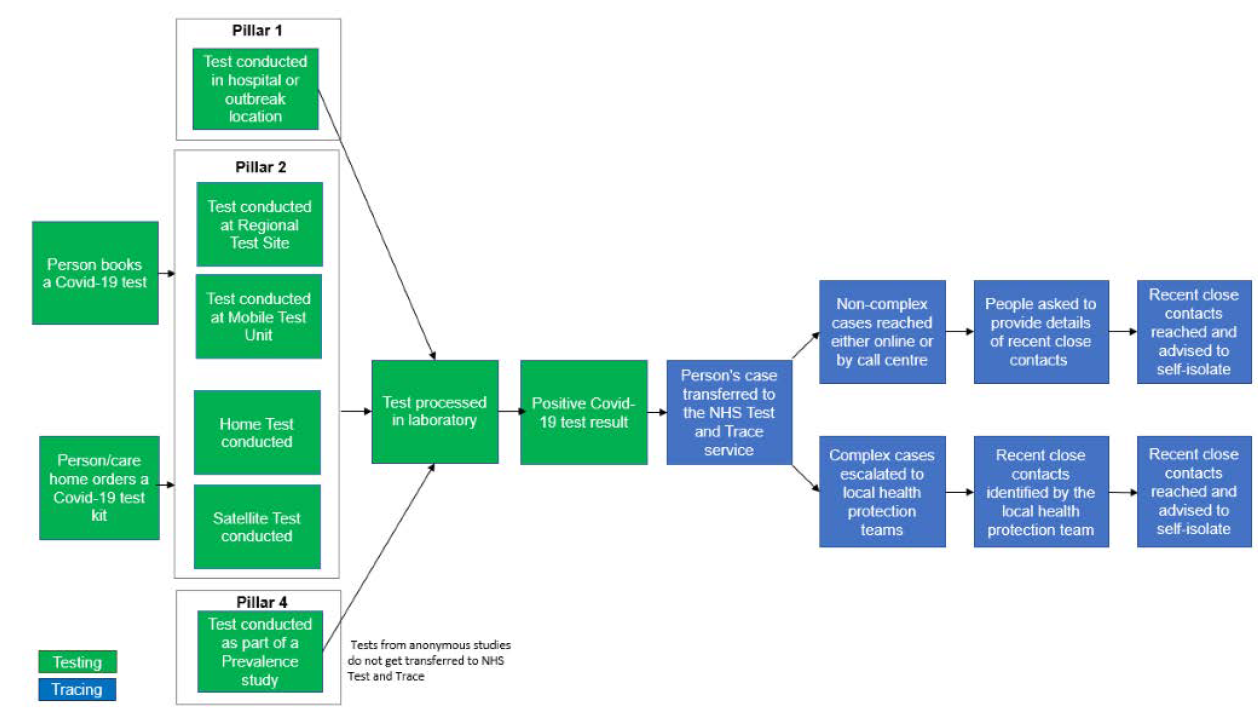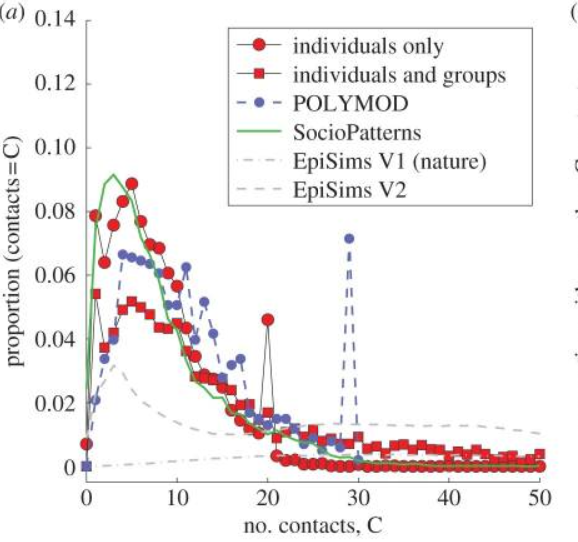We keep getting news stories about contact tracing call-handlers with nothing to do. The Guardian is especially keen on these and seems to either think they are just idle and need scolding, or else they should be laid off for reasons of economy, as there’ll be no problem bringing them back in future. Strangely, it hasn’t bothered to ask what the system’s intended capacity is; if the idea is to provide for the 5,000 cases a day recorded at the peak of the outbreak, it’s going to be pretty quiet with less than 1,000.
The most convincing, really the only, argument other than just “they’re just plain lazy” or “it’s the conspiracy! see! see!” I’ve seen is one from reader Oliver Rivers who suspected that somehow cases were not being referred. The government issues quite a detailed weekly statistical return on the programme here. For the most recent week, 4,973 cases out of 5,212 were referred, a 95.4% referral rate. This isn’t a large difference.
After referral, this flowchart (Figure 1 in the report) suggests a determination is made whether a case is part of a “complex outbreak” or not. Complex cases are defined as ones linked to other outbreaks or in settings like care homes, schools, prisons, etc – in other words, actual or potential clusters. These cases are referred for a local outbreak investigation. Other cases are referred to the call centre. This distinction has taken on almost cosmic political importance, probably because the tracing hit-rate for outbreak investigations is much, much higher, running between 95 and 98%, while that for the call centre is currently around 60%. As a result, “local” response has been coded as generally good and “central” response as generally bad.
Maybe the call handlers are just bad people, but I think it’s going to be impossible to understand this without thinking in terms of what we know about the virus itself. Although the famous R0 value seems to be a bit over 2, k – the parameter that measures the super-spreading phenomenon – is the new R, and it’s been estimated at 0.16, implying that 10% of cases account for 80% of the transmission. Cluster outbreaks have driven the pandemic since the very beginning. The very idea of a cluster implies that the people in it have a lot of contacts, and in fact, the 291 complex cases reported in the current return yielded some 7,907 suspect contacts, or 27 each on average. This compares with around 4 each for the non-complex ones. What we need to know now is how many close contacts people have.
In 2013, the Medical Research Council funded a study by researchers at Liverpool and Warwick that surveyed 5,000 Britons to answer just this question, specifically in order to inform pandemic epidemiology. They found that the distribution of contacts per day follows a pattern typical of social networks and in fact of networks of all kinds, with a small subset of the population having many, many contacts. Technically, the data displayed a power-law distribution, something characteristic of a so-called scale-free network. The average was about 8, but this is misleading – considerably more people reported 4 or 5 daily contacts. The spikes above 20 and 30 are because the survey forms involved didn’t go any higher, so the long tail of people with enormous numbers of contacts is stuffed into the top bucket. These results were very close to several other teams’ results, as you can see in the chart below.
So how well is the contact-tracing effort actually doing? For a start, the local outbreak investigators are clearly getting at the complex cases. Figure 10 in the return shows that the first three weeks after tracing was resumed on the 25th of May saw a dramatic drop in the numbers of suspect contacts being generated by clusters. This is evidence of my thesis in this post, that the government’s decision to stop outbreak investigations was a disaster of epic proportions. Cluster busting got us out of lockdown.
On the other hand, seeing as the cases with lots of close contacts are being selected for local investigation (we might say “prioritised”), an average 4 or so daily contacts for the others is completely plausible as a sample out of the distribution we’ve just seen. The local outbreak investigations are finding more contacts because they are pursuing cases with lots of contacts. The call handlers are pursuing cases with fewer contacts, and possibly, ones without a well-defined setting. The two tasks are just different, and I don’t see a strong argument that the call handlers would get more contacts per case if they reported to local councils, were TUPEd over to the civil service, or were just scolded more.
If we go back to this post for a moment, we’ve got a useful benchmark. The Kucharski et al paper that started the whole tracing ball rolling estimated that an outbreak with an overall R0 value of 2.5 – a bit higher than that observed outside settings like cruise ships – would be pushed under Rt = 1 with 70% of contacts traced and down to 0.8 with 80% tracing success. The current overall hit rate is 75%, and we seem to be getting the sort of results that paper suggests we could expect with those inputs.
In conclusion, I’m mostly depressed that the media has managed to turn this into yet another peripheral theatre of the culture wars. As in real warfare, when the great powers’ rivalries get such a theatre involved, they usually leave it devastated. Every time I have read the Guardian‘s coverage of this I have come away feeling actively disinformed. What was the data protection issue about? This got a lot of press but none of it made any effort to find out what the legalities were.
As far as I understand it, the call centre is there to handle bulk numbers of cases with small contact networks, keeping this workload away from the local outbreak-investigation teams, with a view to coping with a second spike. There might be an argument that we should concentrate exclusively on investigations and rely on the ONS’s sample study for surveillance, but that both sounds pretty brave in the Yes, Minister sense of the word, and in the sense that you need the courage of your convictions to actually say it, rather than covering it as an obscure briefing war between institutions with a side-order of yelling at call centre operatives.
Also, it’s possibly worth remembering that the Financial Times was incautious enough to let on that the newspapers are meant to make Matt Hancock “the fall guy” in order to protect Boris Johnson.



Local authorities are getting poor quality data, that often comes too late to do anything useful. This is due to a fragmented system dominated by private contractors who do not have any sense of urgency.
Permalink
Permalink